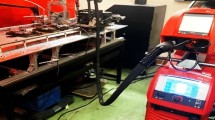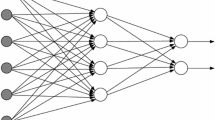Abstract
This paper proposes a back-propagation neural network approach to classify irregular shapes by their convex hulls and brightness in automated production lines. An image-based defect detection and classification system is established, which would examine the quality of rolls of aluminum foil and determine the type of defects, such as bolt, fracture, scratch, or spot on the aluminum foil. The developed approach is capable of performing image acquisition, image processing, defect detection and recognition, and, subsequently, the classification of the aluminum foil sheets by a back-propagation neural network. In order to verify the effectiveness of the developed approach, ten-fold cross-validation is used. The experimental results show that, using a small number of training iterations, the average accuracy rate of classification reaches 96.4%. Thus, the developed approach can be used to replace manual visual inspection for process control and process improvement, which significantly reduces the cost of labor and increases the consistency of product quality.
Similar content being viewed by others
References
Wang C, Huang L, Rosenfeld A (1991) Detecting clouds and cloud shadows on aerial photographs. Pattern Recogn Lett 12(1):55–64
Liu-Yu S, Thonnat M (1992) Using apparent boundary and convex hull for the shape characterization of foraminifera images. In: Proceedings of the 11th IAPR International Conference on Pattern Recognition C: Image, Speech and Signal Analysis, vol III, pp 569–572
Wang YS, Griffiths BJ, Wilkie BA, Silverwood PA, Norgate P (1994) Complex and coloured object inspection. Comput Ind 25(2):125–130
Green K, Eggert D, Stark L, Bowyer K (1995) Generic recognition of articulated objects through reasoning about potential function. Comput Vis Image Underst 62(2):177–193
Tsai D-M (1996) Locating overlapping industrial parts for robotic assembly. Int J Adv Manuf Technol 12(4):288–302
Park J, Kurz L (1996) Unsupervised segmentation of textured images. Inform Sci 92(1–4):255–276
Burge W, Burger M, Mayr W (1996) Learning to recognize generic visual categories using a hybrid structural approach. In: Proceedings of the IEEE International Conference on Image Processing (ICIP’96), Lausanne, Switzerland, vol 2, pp 321–324
Atiquzzaman M (1999) Coarse-to-fine search technique to detect circles in images. Int J Adv Manuf Technol 15(2):96–102
Deglint HJ, Rangayyan RM (2005) Segmentation of neuroblastoma in CT images using deformable contours, image reconstruction, and convex hulls. In: Proceedings of the 3rd IEE International Seminar on Medical Applications of Signal Processing, London, UK, November 2005, pp 29–34
Bishop CM (1995) Neural networks for pattern recognition. Clarendon Press, Oxford, UK
Sing JK, Basu DK, Nasipuri M, Kundu M (2005) Self-adaptive RBF neural network-based segmentation of medical images of the brain. In: Proceedings of the 2nd IEEE International Conference on Intelligent Sensing and Information Processing, Chennai, India, January 2005, pp 447–452
Witten LI, Frank E (2005) Data mining: practical machine learning tools and techniques. Morgan Kaufmann, San Francisco, California
Han J, Kamber M (2003) Data mining: concepts and techniques. Morgan Kaufmann, San Francisco, California
Xu K, Luxmoore AR, Deravi F (1997) Comparison of shape features for the classification of wear particles. Eng Appl Artif Intell 10(5):485–493
Hou T-H, Pern M-D (1999) A computer vision-based shape-classification system using image projection and a neural network. Int J Adv Manuf Technol 15(11):843–850
Shiau Y-R, Tsai I-S, Lin C-S (2000) Classifying web defects with a back-propagation neural network by color image processing. Tex Res J 70(7):633–640
Stojanovic R, Mitropulos P, Koulamas C, Karayiannis Y, Koubias S, Papadopoulos G (2001) Real-time vision-based system for textile fabric inspection. J Real-Time Imag 7(6):507–518
Visen NS, Paliwal J, Jayas DS, White NDG (2004) Image analysis of bulk grain samples using neural networks. J Can Biosyst Eng 46:711–715
Chuang YK, Kusiak A (1994) Grouping parts with a neural network. J Manuf Sys 13(4):262–275
Bogdanov AV, Sandven S, Johannessen OM, Alexandrov VY, Bobylev LP (2005) Multisensor approach to automated classification of sea ice image data. IEEE Trans Geosci Remote Sens 43(7):1648–1664
Iannino A, Shapiro SD (1979) An iterative generalization of the Sobel edge detection operator. In: Proceedings of the IEEE Computer Society Conference on Pattern Recognition and Image Processing. Chicago, Illinois, August 1979, pp 130–137
Kapur JN, Sahoo PK and Wong AKC (1985) A new method for gray-level picture thresholding using the entropy of the histogram. Comput Vis Graph Image Process 29(3):273–285
Yao AC-C (1981) A lower bound to finding convex hulls. J ACM 28(4):780–787
Day AM (1988) Planar convex hull algorithms in theory and practice. Comput Graph Forum 7(3):177–193
Matsunaga A, Ogawa K (2000) Scatter correction in multinuclide data acquisition by means of a neural network. In: Proceedings of the IEEE Nuclear Science Symposium, Seattle, Washington, October 1999, vol 2, pp 948–952
Salzberg SL (1997) On comparing classifiers: pitfalls to avoid and a recommended approach. Data Min Knowl Disc 1(3):317–328
Author information
Authors and Affiliations
Corresponding author
Rights and permissions
About this article
Cite this article
Lin, SW., Chou, SY. & Chen, SC. Irregular shapes classification by back-propagation neural networks. Int J Adv Manuf Technol 34, 1164–1172 (2007). https://doi.org/10.1007/s00170-006-0667-3
Received:
Accepted:
Published:
Issue Date:
DOI: https://doi.org/10.1007/s00170-006-0667-3




